Namibia is emerging as a significant player in Africa’s oil and gas sector, particularly with the recent discoveries in the offshore Orange Basin.
The region gained considerable attention in 2022 when major players like Shell and TotalEnergies announced the discovery of light oil and natural gas in the Graff and Jonker fields.
This momentum continued into 2023 with Galp’s announcement of its Mopane discovery, further elevating Namibia’s status as a global exploration hotspot.
Despite the excitement, Namibia is yet to achieve any commercial production.
However, the three major discoveries made since 2022, particularly the TotalEnergies Venus find – which potentially holds over one billion barrels of recoverable oil – could change the landscape dramatically.
The commercial viability of these discoveries remains contingent on further appraisal, addressing critical factors such as reservoir quality and gas/oil ratios.
If developed, the Venus project would be notable as the deepest offshore development ever undertaken in Namibia.
According to a recent report by AOW Energy, TotalEnergies is expected to begin production around 2028, with all three major projects potentially nearing a combined output of one million barrels per day by early 2030.
The surge in interest surrounding the Orange Basin has also sparked competition among major oil companies.
Chevron, Woodside, and Rhino Resources, holding adjacent acreage to Galp’s block, are planning exploratory campaigns in 2024/25, indicating a growing confidence in the region’s potential.
While offshore developments are capturing headlines, onshore exploration is also making strides.
In July, Reconnaissance Energy commenced drilling at the Naingopo exploration well, marking an important milestone for previously untapped basins.
Additionally, the Kudu gas field, discovered in 1974, has seen renewed interest under BW Energy, which aims to commence drilling as early as next year.
Despite the promising developments, challenges persist. The potential for disputes over resource access, such as the diamond-rich areas around Lüderitz, could pose obstacles.
In addition, Namibia’s vast licensed acreage of 230,000 square kilometres stands in stark contrast to the limited exploration activity, with only 20 deepwater wells drilled compared to the thousands in more established regions like the North Sea and Gulf of Mexico.
Namibia’s national oil company, NAMCOR, is taking steps to change this narrative by aspiring to become a fully-fledged operator.
The company is looking to expand into downstream sectors and sustainable energy, including hydrogen and synthetic fuels.
JN/APA


